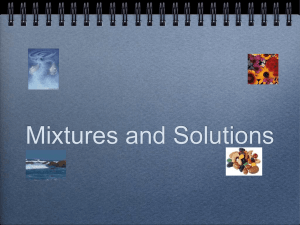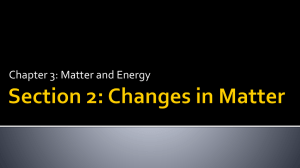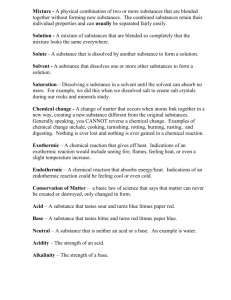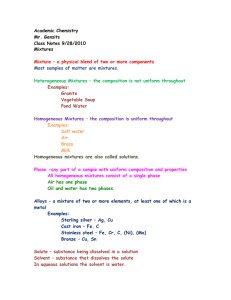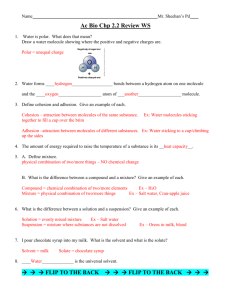Changes in Matter Notes
advertisement
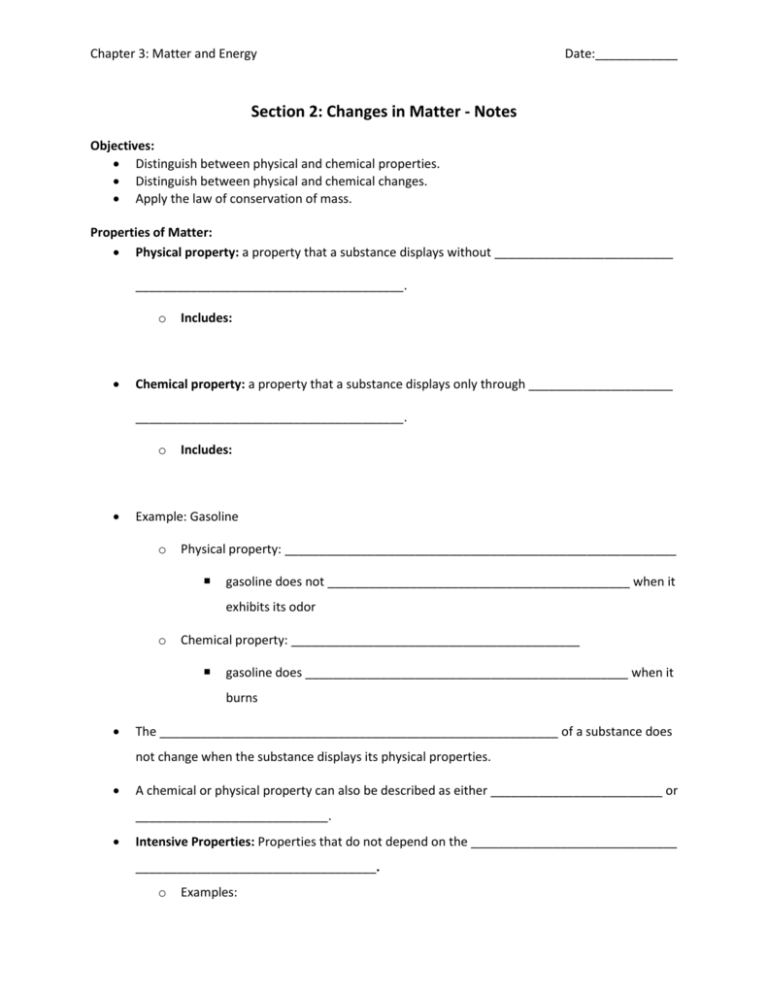
Chapter 3: Matter and Energy Date:____________ Section 2: Changes in Matter - Notes Objectives: Distinguish between physical and chemical properties. Distinguish between physical and chemical changes. Apply the law of conservation of mass. Properties of Matter: Physical property: a property that a substance displays without __________________________ _______________________________________. o Includes: Chemical property: a property that a substance displays only through _____________________ _______________________________________. o Includes: Example: Gasoline o Physical property: _________________________________________________________ gasoline does not ____________________________________________ when it exhibits its odor o Chemical property: __________________________________________ gasoline does _______________________________________________ when it burns The __________________________________________________________ of a substance does not change when the substance displays its physical properties. A chemical or physical property can also be described as either _________________________ or ____________________________. Intensive Properties: Properties that do not depend on the ______________________________ ___________________________________. o Examples: Extensive Properties: Properties that do depend on the ________________________________ ____________________________________. o Examples: Changes in Matter: Physical property: the boiling point of water o How is the water changing once it boils? When water boils, it turns into ______________, but the water molecules are the __________ in both the _____________________________ and the _______________________________. Physical change: matter changes its appearance but ___________________________________ o When ice melts, it looks different but its _______________________________________ is the same. Solid ice and liquid water are both composed of ______________________ molecules, so melting is a physical change. Chemical change: matter does change _________________________________________ o For example, copper turns green upon continued exposure to air because it reacts with gases in air to form __________________________________. This is a chemical change. State changes: transformations from one state of matter to another, such as from solid to liquid o These are _________________________________________________ Condensation o Freezing o o Melting o Evaporating Sublimation o Deposition o Physical changes include: Four good indications of a chemical change: A chemical property: The susceptibility of iron to rusting. o Is rusting a physical or chemical change? Practice: o When iron rusts, it turns from ________________________________________. Classify each property as physical or chemical. a) the tendency of copper to turn green when exposed to air c) the tendency of gasoline to evaporate quickly when spilled b) the tendency of automobile paint to dull over time d) the low mass (for a given volume) of aluminum relative to other metals Matter undergoes a chemical change when it undergoes a ______________________________ _________________________________. In a chemical reaction, the substances present before the chemical change are called ___________________. The substances present after the change are called ________________. The difference between chemical and physical changes is seen at the ______________________ __________________________________. In physical changes, the atoms that compose the matter do not change their ______________________________________________, even though the matter may change its _______________________________. o A physical change results in a __________________________________ of the _______________________________. In chemical changes, atoms do change their __________________________________________, resulting in matter with a ________________________________. o A chemical change results in a ______________________________________________. Practice: o Classify each change as physical or chemical. a) the rusting of iron b) the evaporation of fingernail-polish remover (acetone) from the skin c) the burning of coal d) the fading of a carpet upon repeated exposure to sunlight Separation of Mixtures: Compounds are ___________________________________________ o Mixtures can never consist of only a ____________________________________________ o Compounds can only be separated by _________________________________________ Mixtures can be separated by _______________________________________________ Filtration o Separates ______________________________________ o The mixture is poured over a mesh-like filter paper and the ___________________ is allows to pass through, leaving behind the _________________ Density o Liquids of ____________________________________________ will separate into layers. o The lowest density liquid will _______________________________. Centrifuge o A centrifuge is a machine that separates _______________________________________ by spinning very quickly. o This causes _________________ to fall to the bottom of the test tube, separating them from the liquids in the mixture. Decant o Separates ___________________________________ by pouring the liquid off the top and leaving the solid behind o It can be difficult to ensure that all of the ______________ is removed by this technique Magnetism o Can be used to remove ______________________________________ from a mixture o Magnetic elements include ______________________________________________ Distillation o To separate a _____________________________________, the liquid can be heated to force components, which have different ______________________________________, into the gas phase. The gas is then ______________________________ back into liquid form and collected. o Can be used to separate several different substances Chromatography o Techniques which use a _______________________________________ (e.g. paper) and a ________________________________ (e.g. some sort of solvent like water or alcohol) to physically separate substances. o A sample of the mixture is placed on the paper (stationary phase). The solvent will then ______________________________ the components of the mixture. o The components of the mixture will __________________ with the solvent (mobile phase) up the paper. o Based on the ______________________________ of each component (e.g., polarity) the components will travel at different ________________________ with the solvent. o Many complex variations, but basic principles stay the same Law of Conservation of Mass: Law of Conservation of Mass: matter is neither created nor destroyed in a ________________________________________. o In a _____________________________________, significant changes in mass can occur. During physical and chemical changes, the total amount of ______________________________ ______________________________________. Suppose that we burn 58 g of butane in a lighter. It will react with 208 g of oxygen to form 176 g of carbon dioxide and 90 g of water. Practice: A chemist forms 16.6 g of potassium iodide by combining 3.9 g of potassium with 12.7 g of iodine. Show that these results are consistent with the law of conservation of mass. Suppose 12 g of natural gas combines with 48 g of oxygen in a flame. The chemical change produces 33 g of carbon dioxide. How many grams of water form?
